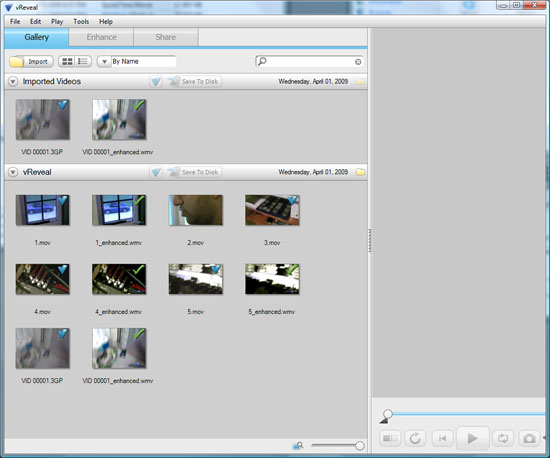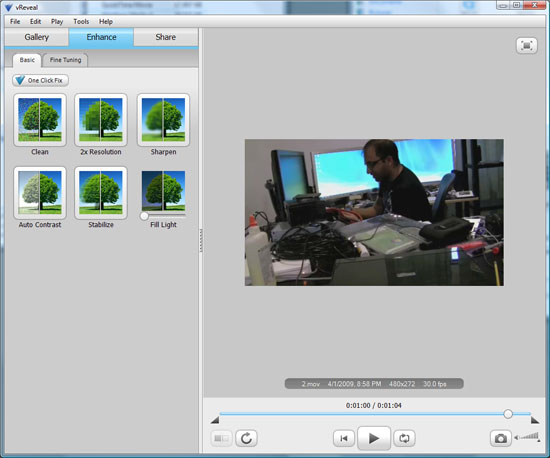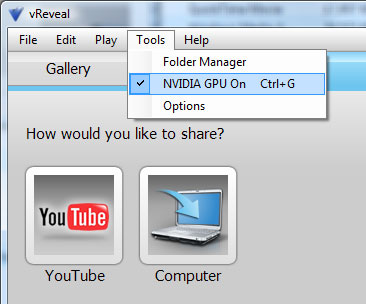ATI Radeon HD 4890 vs. NVIDIA GeForce GTX 275
by Anand Lal Shimpi & Derek Wilson on April 2, 2009 12:00 AM EST- Posted in
- GPUs
The Latest CUDA App: MotionDSP’s vReveal
NVIDIA had more slides in its GTX 275 presentation about non-gaming applications than it did about how the 275 performed in games. One such application is MotionDSP’s vReveal - a CUDA enabled video post processing application than can clean up poorly recorded video.
The application’s interface is simple:

Import your videos (anything with a supported codec on your system pretty much) and then select enhance.

You can auto-enhance with a single click (super useful) or even go in and tweak individual sliders and settings on your own in the advanced mode.
The changes you make to the video are visible on the fly, but the real time preview is faster on a NVIDIA GPU than if you rely on the CPU alone.

When you’re all done, simply hit save to disk and the video will be re-encoded with the proper changes. The encoding process takes place entirely on the GPU but it can also work on a CPU.
First let’s look at the end results. We took three videos, one recorded using Derek’s wife’s Blackberry and two from me on a Canon HD cam (but at low res) in my office.
I relied on vReveal’s auto tune to fix the videos and I’ve posted the originals and vReveal versions on YouTube. The videos are below:
In every single instance, the resulting video looks better. While it’s not quite the technology you see in shows like 24, it does make your videos look better and it does do it pretty quickly. There’s no real support for video editing here and I’m not familiar enough with the post processing software market to say whether or not there are better alternatives, but vReveal does do what it says it does. And it uses the GPU.
Performance is also very good on even a reasonably priced GPU. It took 51 seconds for the GeForce GTX 260 to save the first test video, it took my Dell Studio XPS 435’s Core i7 920 just over 3 minutes to do the same task.
It’s a neat application. It works as advertised, but it only works on NVIDIA hardware. Will it make me want to buy a NVIDIA GPU over an ATI one? Nope. If all things are equal (price, power and gaming performance) then perhaps. But if ATI provides a better gaming experience, I don’t believe it’s compelling enough.
First, the software isn’t free - it’s an added expense. Badaboom costs $30, vReveal costs $50. It’s not the most expensive software in the world, but it’s not free.
And secondly, what happens if your next GPU isn’t from NVIDIA? While vReveal will continue to work, you no longer get GPU acceleration. A vReveal-like app written in OpenCL will work on all three vendors’ hardware, as long as they support OpenCL.
If NVIDIA really wants to take care of its customers, it can start by giving away vReveal (and Badaboom) to people who purchase these high end graphics cards. If you want to add value, don’t tell users that they should want these things, give it to them. The burden of proof is on NVIDIA to show that these CUDA enabled applications are worth supporting rather than waiting for cross-vendor OpenCL versions.
Do you feel any differently?










294 Comments
View All Comments
Warren21 - Thursday, April 2, 2009 - link
Yeah, I don't know why they're playing this off as an RV770 overclock. RV790 is indeed a respin of RV770, but hey if nV can get by with 1000 different variants on the same GT200... Why not mention the benefits/differences between the RV770 and the RV790? Disappointed.SiliconDoc - Monday, April 6, 2009 - link
I guess they didn't mention the differences ? Tell you what, when ati gets 999 more rebrands and catches up with their competitotr, we'll call it even, ok ?In the mean time, the 4870 crossfires with the 4980, and soon enough we'll have the gamer joe reviewers that downclock the 4890 and find it has identical results to the same clocked 4870 - at that point the red roosters will tuck their flapping feathers and go home.
I know, it's hard to see it coming, when all you can see is s tiny dot of red, in a sea of 1000 choices of green. rofl
bill3 - Thursday, April 2, 2009 - link
According to info at other sites, the 4890 has 3 million more transistors (959 instead of 956, very little difference). It also has a somewhat larger die due to tweaks made to allow the higher clocks.Go to Firing Squad or Xbitlabs review, both have an certain ATI slide that explains the small changes in detail.
SiliconDoc - Monday, April 6, 2009 - link
" Because they’re so similar, the Radeon 4870 and 4890 can be combined together for mix-and-match CrossFire, just like the 4850 and 4870. "I guess it's not a rebrand.
roflmao
bill3 - Thursday, April 2, 2009 - link
http://www.firingsquad.com/hardware/ati_radeon_489...">http://www.firingsquad.com/hardware/ati..._4890_nv...The slide is the first clickable pic on that page, actually. Didn't realize we could do links.
bill3 - Thursday, April 2, 2009 - link
Or even betterhttp://www.firingsquad.com/hardware/ati_radeon_489...">http://www.firingsquad.com/hardware/ati...0_nvidia...
heh
Proteusza - Thursday, April 2, 2009 - link
Thanks guys, good read.The piece on PhysX kinda mirrors my thoughts on it - its not worth basing a GPU purchasing a decision on it because it affects so few games. If you design your game around PhysX, you end up making a gimmicky game, if you design a good game and think of good ways to let PhysX enhance it, you can make something good like Mirror's Edge.
The way I think about PhysX is based on Amdahl's law, which says that overrall speedup of a CPU from an enhancement that affects only a certain class of application is affected by the amount of time spent using that certain class of application. In the case of PhysX, the amount of time spent using it is generally extremely low, and when it is used the effect isnt always noticeable or worth having.
NVidia's marketing tactics leave a lot to be desired frankly, although I'm not naive enough to say AMD never tries a little marketing manipulation themselves.
Sylvanas - Thursday, April 2, 2009 - link
Why on earth would you compare a newly released Nvidia driver to that of an ATI driver from December last year and a Hotfix at that? The latest ATI drivers have had substantial improvements in a few games and surely they would have sent you an up to date driver with the 4890 review sample- somethings not right there. Also, where was the overclocking comparisons? (some reviews stating 1ghz core 4890 no problem). What about Temps and Stock cooling fan noise?7Enigma - Thursday, April 2, 2009 - link
I'm a bit disappointed with the ATI card. That is pretty much the Sapphire Vapochill model with increased core (actually it's a slightly slower memory setting). At least the GTX 275 is something different.bill3 - Thursday, April 2, 2009 - link
Wow lol..both cards are just rehashes. Calling the Nvidia card "something different" is a hell of a stretch.. it's just their same other cards with various clocks twiddled for the trillionth time.If anything the ATI card brings more to the table, as it offers much more clock headroom (1ghz is said to be well within reach) due to it's redesign, while the Nvidia card is nothing at all new intrinsically (aka it will overclock similar to the 285). Too be fair Nvidia's better clock-capable models (285) just came out a couple months earlier instead of now.